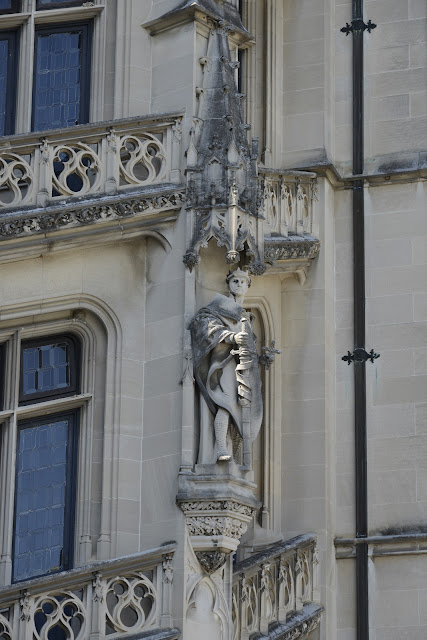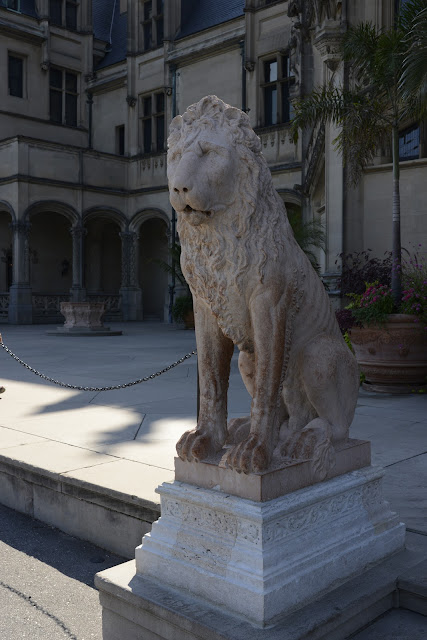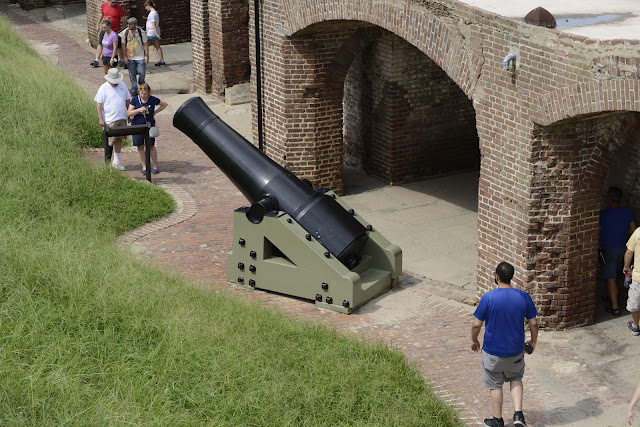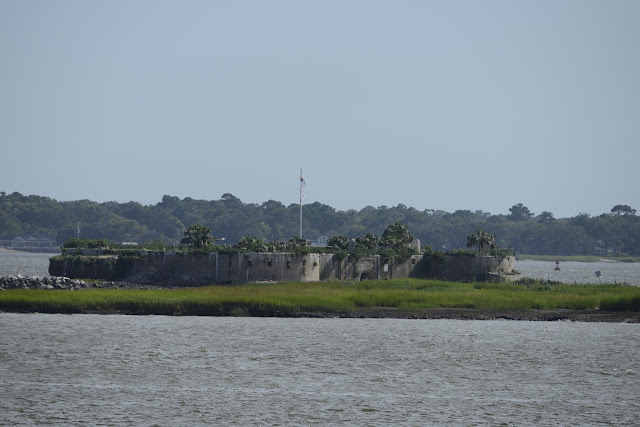Planning the Visit
One of the first places we considered visiting when we began thinking about a trip through the southeast U.S. was the Biltmore House. This is a 250 room French-style chateau built in 1895 by George Vanderbilt, one of the heirs to the Vanderbilt fortune, in the foothills of the Blue Ridge Mountains outside of Asheville, North Carolina.
After I started looking into it more I was shocked by the cost to visit. The entrance fees are complicated and seem to depend on a number of factors, but a walk up ticket was on the order of $75 per person per day. I looked at reviews on several sites like TripAdvisor. Although several people mentioned the high cost, they all seemed to think it was worth it That alone was noteworthy, since I would have thought someone would have complained. I was skeptical, but I did not rule it out yet.
The next thing I looked at was how long to plan for our visit. The more I looked into things the more confused I got. Visiting Biltmore is not just a tour of the mansion. There seemed to be so much more...the gardens, winery, multiple restaurants, outdoor activities (hiking, biking, horseback riding, off road driving experience), not to mention special tours of the house beyond the basic self-guided tour. Everyone seemed to think a day was the bare minimum, with some folks staying at one of the hotels on site and spending up to a week. I looked briefly at staying in one of the hotels on site to take better advantage of the onsite attractions in the evening, but they were really expensive.
What to do?
It would take nearly half a day to drive from Charleston to Asheville. I hated to pay a full day's entry fee for only a half day visit, especially if we would have to pay for entry again the following day if only half a day at the Biltmore was not enough. Then I encountered yet another complication. As part of the Biltmore's summer concert series, there would be an outdoor concert, (REO Speedwagon) on Thursday evening. We assumed this meant there would be a very large crowd starting Thursday afternoon.
A solution
Almost by accident I noticed on the website for the Hampton Inn (the one off of I-26, not the nearest one to the entrance to the estate) a special Biltmore Package. For an extra $100 you get two adult admissions to the Biltmore for two consecutive days. That was exactly what we needed! We could drive to Asheville on Wednesday morning, check-in to the hotel before lunch, spend the afternoon touring the Biltmore mansion on Wednesday afternoon in the heat of the day, then return the following morning and explore the gardens before it got too hot. That would also allow us to leave before the rush of concert goers later on Thursday afternoon. That is exactly what we did. We still did not see many of the things we could have seen, including the winery tour and free wine tasting, but we just ran out of time because there was SO MUCH that we did see.
Arriving at Biltmore
Despite all of the time preparing for the visit, the Biltmore was so much different than what I had anticipated. That is especially true of the grounds. Even though everything on their website indicates the need for a car, I had not realized the huge size of the estate. After making our way through the guard house just off the street in Biltmore Village, we drove and drove and drove through a thick forest. We finally got to a turn off, but that was merely to the parking lot. There we were picked up by a shuttle bus to take us to the mansion.
It was still further along that we finally broke through the trees to see the massive home with its 375 foot wide front facade spread out beyond the huge lawn.
 |
| The Turkey standing next to the fountain for scale. |
It is three miles from the front gatehouse to the mansion. I am not sure how long it took us since the speed limit was low (15 mph, I think), but nothing like the hour it took George Vanderbilt's guests in horse drawn carriages when the house first opened. The effect is still the same. Finally seeing the house for the first time after winding three miles through the woods made it much more breath-taking.
The dramatic reveal of the house was by design, specifically that of the garden's architect, Frederick Law Olmsted. Olmsted, considered the father of American landscape architecture, designed not only the grounds here at Biltmore, but a long list of other locations around the country including New York's Central Park, many other city parks around the country, and multiple university campuses, including Stanford and Denison. He had a lot to work with. Although now only about 7000 acres or 11 square miles, the original estate at Biltmore was 125,000 acres (195 sq miles)!
BTW...For comparison I looked up the largest ranch in Texas, King Ranch, which is 825,000 acres or 1,289 sq mi--roughly the size of Rhode Island. The largest ranch in north Texas, the Waggoner Ranch recently purchased by Stan Kroenke (owner of the Los Angeles Rams and other sports franchises), is over 520,000 acres or 800 sq mi.
Although the ranches in Texas may be larger, the Biltmore has the Blue Ridge Mountains. Most importantly, neither of these ranches has anything to compare with the Biltmore Mansion. The house is enormous, what the Biltmore's brochure claims is the largest private home in America. It has 250 rooms, 34 bedrooms, 43 bathrooms, and three kitchens. Included in these rooms are 65 fireplaces, although they are constructed such that there are "only" 16 chimneys. A lot of the other superlatives are listed in this article, that describes some of the behind-the-scenes tours at the Biltmore.
As massive as everything is about the Biltmore Estate, it is the little details everywhere inside and out that makes this place so great.
 |
| Limestone carving on the exterior of the Grand Staircase, some of the detail on the front of the house. |
But the details went beyond just aesthetics. Fully electric and centrally heated, Biltmore House at the time of its completion in 1895 was considered one of the most technologically advanced structures ever built. At a time when indoor plumbing was rare, it had 43 indoor bathrooms with plumbing. Thomas Edison was a friend of George Vanderbilt, so it was perhaps natural that Biltmore had some of Edison's first light bulbs. However, it was not yet clear whether electricity would be AC or DC, so Biltmore was wired for both. With electricity less safe and fire more of a danger at the time, the house had six separate sections divided by brick fire walls. It also had a fire alarm system, an electrical call box system for servants, two elevators, and a relatively newfangled invention called the telephone.
Self-guided tour of the Biltmore House
We decided to take the self-guided tour through the house. The self-guided tour is not random, but follows a specific route through the building. There are good descriptions for each area in the brochure, but I paid extra for the audio tour. It gave me lots more detail and also gave me something to do while the Frog was taking pictures.
 |
| The Winter Garden |
 |
| Glass roof of the Winter Garden |
One of the most impressive rooms in the building is the banquet hall with its seven story high ceiling and Flemish tapestries from the mid-1500s. Although I did not test it out, acoustics are supposedly so good that guests at opposite ends of the hall can hear each other with a whisper.
 |
| Triple fireplace at end of banquet hall |
I was particularly intrigued by the sculpture above the fireplace.
 |
| Part of the detail above the triple fireplace entitled “The Return from the Hunt” by Karl Bitter that illustrates a scene from Wagner’s epic Tannhäuser opera. |
I read somewhere that the banquet table is 40 feet long and can seat 64, although I counted considerably fewer chairs at the table the day we were there. In any case, the chairs and oak table were designed by the building's architect, Richard Morris Hunt, for this room.
 |
| Oak table in the banquet hall |
There were lots of other "public" type rooms on the first floor. Everyone of the rooms seemed to have an interesting story about the contents of the room or of how the room had been used by the Vanderbilts and their guests.
 |
| Salon |
Even upon casual inspection, the Music Room is quite beautiful. However, a closer inspection of the work above the fireplace reveals that it is a 10 x 11 foot woodblock cut print entitled "Triumphal Arch of Maximilian" by Alfred Durer. Done about 1515, it may be one of the largest woodblock prints ever made.
 |
| Music Room |
 |
| Loggia |
 |
| Gargoyle on the Loggia |
Although this back side of the house was more informal and had less ornamentation, there were still plenty of interesting little details.
 |
| Library |
There were many stunning details such as the black marble fireplace with the walnut over mantel or the massive painting (a mere 64 feet by 32 feet!) on the ceiling, which is made up of 13 separate canvases and was originally in a palace in Venice.
The Frog was intrigued by the large globe next to the fireplace. A close-up of the date appeared to be 1888.
I thought the chess set and table looked pretty neat. By the way, they had once been owned by Napoleon Bonaparte.
Up to the second floor
The tour then headed upstairs to the second floor via the Grand Staircase. We had seen the location of the staircase from the outside.
We now got a chance to see it from the inside. The Grand Staircase is 102 steps and goes all the way to the fourth floor, although on this tour we would only be as high as the third floor.
 |
| The wrought iron chandelier in the Grand Staircase hangs from a single point and is lit by 72 electric lights, which must have been quite the marvel for its time |
 |
| Looking at Mr. Vanderbilt's bathroom from his bedroom. The reflection in the mirror shows the paw-footed bathtub. Also in the corner is a hot air register. Yes, the house had central heating. |
 |
| Mrs. Vanderbilt's bedroom |
 |
| Oak Sitting Room on the second floor joining the family bedrooms |
Third Floor
The third floor was primarily the guest retreat, with many bedrooms. We must have seen only a small fraction of them, but they were all quite large and all beautifully decorated.
 |
| Madonna Room with a carved cassone or marriage chest at the foot of the bed. |
 |
| Third Floor Living Hall |
Basement
The third floor was probably the least interesting to me because I know so little about period furniture or period decorating. However, next up was the basement, which had lots of really neat stuff.
Access to the basement was down a staircase and through a stone hallway. The walls of the hallway are part of the foundation walls. Because of the enormous size of the building, it took two years to build the foundations and footings, which extend down 29 feet.
 |
| Stone hallway in the basement |
The basement contained recreation areas and servants' areas.
Recreation Area
 |
| Bowling alley |
 |
| Swimming pool, sans water |
 |
| Gymnasium |
Near the recreation area was a massive array of changing rooms. It would have been totally inappropriate to traipse through the main house in workout or swimming attire!
Servants' Area
Much of the basement was devoted to the servants' areas, where the staff lived and worked.
There were massive pantries of different kinds. Although we don't have pictures, there were two large walk-in refrigerators. These worked on an ammonia gas and brine system with the ability to create ice cubes in the summer. This was at a time when any cold storage beyond iceboxes and spring houses was almost unheard of.
 |
| Housekeeper's pantry and office for the head housekeeper |
 |
| Canning pantry for produce grown on the estate |
 |
| Main kitchen |
On one side of the kitchen was the 7.5 foot long stove and a separate grill.
 |
| Stove and grill in the main kitchen |
There were also lots of kitchen gadgets such as a coffee grinder and a mortar and pestle, but everything here was ginormous!
 |
| Coffee grinder in the main kitchen |
 |
| Mortar and pestle |
 |
| Rotisserie Kitchen |
 |
| Mechanized rotary spit with the drip pan below and vent hood above |
There was a drip pan for the grease and a vent hood for the smoke, but keeping this in a separate kitchen reduced the amount of grease and smoke in the main kitchen. There was also a separate Pastry Kitchen.
Laundry
Another large part of the basement was devoted to different laundry functions. The Brown Laundry was equipped with deep tubs and was used for hand laundry These items were also ironed here using various irons heated on a special laundry stove.
 | ||
| Brown Laundry for hand washables. |
 |
| Wash tubs in the Main Laundry. I think it is an extractor in the background |
 |
| Belt-driven barrel washer in Main Laundry |
 |
| Drying Room |
Servants' Living Quarters
Although we did not see any of the upstairs servant's rooms on this tour, we did see some of the rooms in the basement for the downstairs servants.
 |
| Servant's bedroom, one of more than 60 staff rooms at Biltmore |
 |
| Servants' Dining Room |
There were lots of other storage rooms and work rooms in the basement such as an entire room for arranging flowers. This tour did not include the sub-basement where much of the cutting edge technology for the time was in place.
Back upstairs
It was now time to go back upstairs. This time we went up the stairs into the Bachelors' Wing. This included the Billiard Room, a Smoking Room, and a Gun Room.
 |
| Billiard Room |
 |
| On the wall in the Billiard Room |
 |
| View from the front of the house |
 |
| One of the lions on either side of the steps at the main front entry way |
We really enjoyed this tour and saw lots of interesting things. Although this was a long tour, it is still only a portion of this mammoth house. It is unlikely I will ever be there again, but I can see that some of the special tours to other locations in the house could be very worthwhile.
We never could find out how much the house cost originally to build, other than statements in several places to the effect that it may have nearly exhausted all of George Vanderbilt's inheritance. Soon after George Vanderbilt's death in 1914, his wife sold almost 90,000 acres of the estate to the federal government to create the Pisgah National Forest. It was his daughter and her husband that opened a portion of the house to tourists starting in 1930 to help pay for the home's upkeep during the hard times of the Depression.
The estate is still owned by the family. Although members of the family still live on the grounds, the family has not lived in Biltmore House since the 1950s (I think). Currently more than a million people visit Biltmore each year.
We did explore some of the gardens before calling it a day, but that will be a part of the next blog.





























